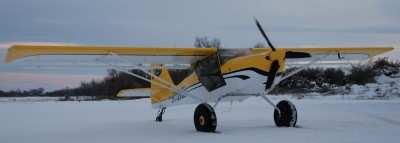Issued Following Risk Analysis Of Cold-Weather Altimetry Errors
After conducting a risk analysis of cold-weather altimetry errors at airports with current FAR Part 97 instrument approaches, the FAA has compiled a list of 272 cold-temperature-restricted airports in 30 states that need altitude corrections to ensure the required obstacle clearance (ROC). When the temperature falls to an airport-specific threshold, pilots are required to correct for the cold temperature and report the corrected altitude to air traffic controllers.

The FAA published the list of cold-temperature-restricted airports, and their corresponding operational requirements, in the general notices section of the Notice to Airman publication. Pilots are not required to make similar cold-weather corrections for airports that are not on the list and have runways 2,500 feet or longer.
Pilots flying aircraft that compensate for temperature must ensure their onboard system is working correctly for each segment of the approach – intermediate, final, and/or missed approach – that requires an altitude correction. This includes minimum descent altitude and decision altitude. Pilots without temperature compensation systems must use the Aeronautical Information Manual 7-2-3 ICAO Cold Temperature Error Table.
In increments of 10 degrees Celsius, the ICAO table gives the altitude correction for given altitudes above the airport in feet. Pilots add that correction to the appropriate altitude for that segment of the approach. For example, if the temperature is -30 degrees Celsius, and the published altitude for the segment is 3,000 feet, pilots would add 570 feet and report – and fly – the sum altitude: 3,570 feet.
The cold-weather correction NOTAM stresses repeatedly that the "pilot should not make an altimeter change." With or without aircraft temperature compensation, pilots must ensure they are flying the temperature-corrected altitude, and pilots must report this cold-corrected altitude on initial contact with the ATC facility issuing the approach clearance. The NOTAM gives phraseology examples: "Require 3,570 feet for cold temperature operations until BEEAR." In addition, pilots should not apply cold temperature corrections to altitudes assigned by ATC as a result of an assigned heading or a radar vector off of the published missed approach procedure.
The NOTAM procedures are required for any pilot flying to a cold-temperature-restricted airport when the temperature at the facility reaches its correction threshold. Pilots must correct the affected segment for all approaches to all runways unless the airport list specifies otherwise. For example, at Chicago Midway International Airport (MDW) pilots must correct the intermediate segment altitudes on all approaches to Runway 22L and 22R. No correction is needed when Runway 22L and 22R are not the active runways.
In its risk assessment, the FAA used the coldest recorded temperatures at these airports in the last five years. Airports made the list if the probability of exceeding the ROC on non-standard days surpassed 1 percent on a segment of the approach, and that segment received the temperature restriction.
This General Notice in the Notice to Airmen Publication is temporary measure until such time that the critical temperature limit for the affected airports can be annotated on the applicable instrument approach procedure plate. Refer to the chart provider’s legend for the form of annotation provided.
 Airborne 04.16.24: RV Update, Affordable Flying Expo, Diamond Lil
Airborne 04.16.24: RV Update, Affordable Flying Expo, Diamond Lil ANN's Daily Aero-Term (04.20.24): Light Gun
ANN's Daily Aero-Term (04.20.24): Light Gun Aero-News: Quote of the Day (04.20.24)
Aero-News: Quote of the Day (04.20.24) Aero-News: Quote of the Day (04.21.24)
Aero-News: Quote of the Day (04.21.24) ANN's Daily Aero-Term (04.21.24): Aircraft Conflict
ANN's Daily Aero-Term (04.21.24): Aircraft Conflict



